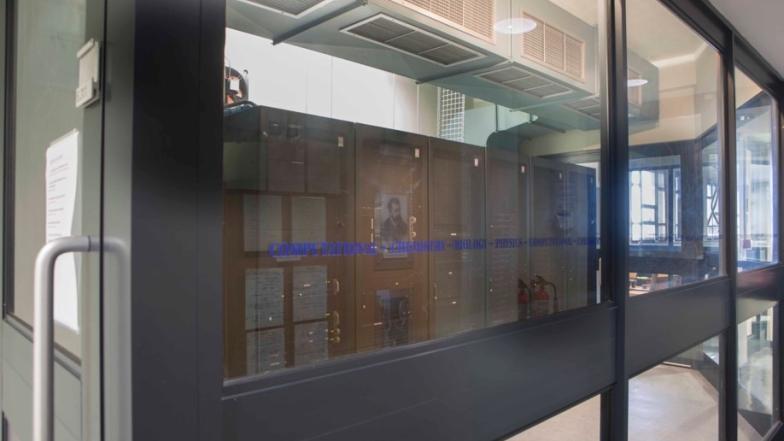
The focus of this laboratory is the development of algorithms, modules and packages needed for life science modelling. In the absence of secondary structures for the glycoenzymes identified as targets for cancer and respiratory diseases, we use a combination of homology methods and the SCRU Free Energy Force Induced (FEFI) coarse grain MD to generate the protein structures. These structures are used to develop models for reaction simulations. Following the modelling process, the multidimensional reaction dynamics of complex glycoenzyme catalytic mechanisms are made possible from the SCRU’s development of a Free Energy from Adaptive Reaction Coordinates (FEARCF) Library. Ab Initio quantum dynamics and free energy method make the accurate depiction of glycoenzyme targets identified from gene expression feature discovery generated in the informatics lab possible. This accuracy is only possible because the SCRU developed Quantum Supercharger Library (QSL) is capable of rapidly computing wave functions for GAMESS-UK, NWChem and other legacy codes. The Computation and Modelling Laboratory’s primary objective is to use these accurate reaction mechanisms to design therapeutics for Cancer and Respiratory diseases. The designed therapeutics from the ab initio quantum level simulations of the enzyme catalysed reactions are tested in the Glycobiomedical laboratory.
Life Science HPC Development Group

This group’s primary strategy is to enhance the capabilities of molecular simulation codes commonly used by chemists, biophysicists and chemical biologists through the development of functional libraries and modules that link into the legacy codes. The group developed scientific software libraries and collaborate with legacy code developers to create links between our accelerated wavefunction libraries (QSL), Free Energy and Reaction Dynamics (FEARCF) and QM/MM polar bond link atom (SLASH) libraries; firstly with NWChem and then other codes such as GROMOS. We develop methods for chemical and glycochemical biological applications. Our laboratory designed a new method to model the boundary between quantum and classical compartments for polar (glycosidic bonds) making it possible to accurately compute complex glycans using a mixed quantum classical QM/MM model. We call this the Simple Link Atom Hybrid Saccharide (SLASH) method. The group has developed semi-empirical quantum methods to model chemical glycobiological events that we termed AM1/d-CB1. We develop tools to use a coarse grained potential functions embedded in molecular dynamics calculations to fold and refine protein and glycan conformations. Our specific structural interests are glycosyltransferases, glycosidases and glucokinases. The development of the Free Energy Force Induced (FEFI) coarse grained MD method built on multidimensional free energy profiles These methods developed for the Computational GlycoEnzymology Group make it possible to simulate glycosylation reactions more accurately and design enzyme inhibitors.
References:
Werner Crous, Martin J. Field, and Kevin J. Naidoo, Simple Link Atom Saccharide Hybrid (SLASH) Treatment for Glycosidic Bonds at the QM/MM Boundary, J. Chem. Theor. Comput. 2014 10 (4), 1727-1738
Krishna Govender, Jiali Gao and Kevin J. Naidoo. AM1/d-CB1: A Semiempirical Model for QM/MM Simulations of Chemical Glycobiology Systems. J. Chem. Theor. Comput. 2014, 10, 4694-4707 Naidoo, K. J., Multidimensional free energy volumes offer unique insights into reaction mechanisms, molecular conformation and association. Phys. Chem. Chem. Phys. 2012, 14, 9026-9036.
Ananya Gangopadhyay, Simon Winberg and Kevin J. Naidoo, Anisotropic numerical potentials for coarse-grained modelling from high-speed multidimensional lookup table and interpolation algorithms Comp. Chem. 2021 Vol. 42 Issue 10 Pages 666-675
Computational GlycoEnzymology Group

Glycoenzymes (Glycosyltransferases and Glycosidases) are targets for the clinical treatment of several diseases. In this group we focus on Glycosyltransferases (GTs) that play a central role in cancer i.e., tumour development and Neuraminidases (NANs) central to the infection cycle of respiratory related pathogens.
We principally used methods developed in the Life Science HPC Group to discover enzyme reaction mechanisms and Transition State (TS) profiles. This group focuses on investigating the mechanisms of catalytic reactions of GTs and NANs, which process saccharides and alter the glycans on tumour cells and scavenge sialyltransferases from hosts cells. From this a rational design of cancer immunotherapeutics and drugs targeting pneumonia, influenza and coronavirus narrow the testing space for the research group in the Glycobiomedical Laboratory and biological testing system. We develop from this both Glycomimetics as well as repurposed drug solutions.
References:
Barnett, C. B.; Wilkinson, K. A.; Naidoo, K. J., Molecular Details from Computational Reaction Dynamics for the Cellobiohydrolase I Glycosylation Reaction. J. Am. Chem. Soc. 2011, 133, 19474-19482.
Ian L. Rogers and Kevin J. Naidoo, Multidimensional Reaction Dynamics Reveal How the Enzyme TcTS Suppresses Competing Side Reactions and Their Side Products ,ACS Catalysis 2016 Pages 6384-6392.
Laboratory Infrastructure and Resources

The SCRU hardware platform includes state of the art GPU clusters, data servers and Infiniband clusters. The compute capability is modest and designed for code development, modelling testing and short simulations prior to using either the national HPC facility (CHPC) or the UCT and regional facility (Ilifu). Our computing environment is set up for computational software developed in-house, from academic developers to commercially licenced. These have been modularized to allow users to manage their environment either in an interactive session or a batch job. Our software modules also enhance users to dynamically change environments user workstations in the computation and modelling lab perform computations on the GPU and CPU cluster computer nodes.
